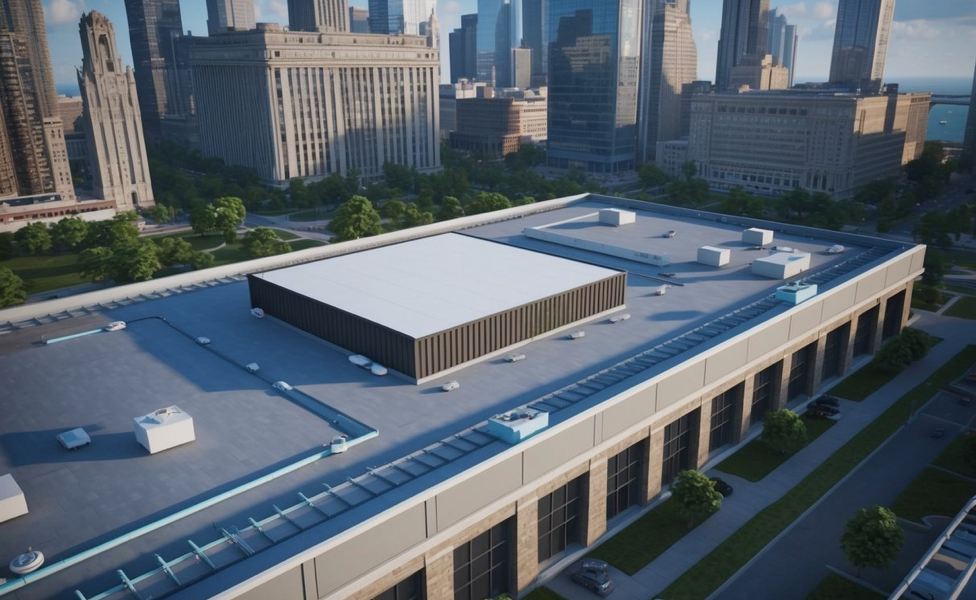What Kind Of Commercial Roof Is Right For Your Business in Chicago: A Guide to Optimal Choices
Choosing the right commercial roof for your business in Chicago is a big decision. The roof protects your building and impacts energy costs. Chicago’s weather can be harsh, with hot summers and cold, snowy winters. This makes picking a durable roof even more important.
There are several types of commercial roofs to pick from. Each has good and bad points. The best commercial roof for your Chicago business depends on your budget, building type, and specific needs. Some common options are metal roofs, built-up roofs, and single-ply membranes.
Commercial roofing choices vary in cost, lifespan, and how well they handle Chicago’s climate. A good roof can save money on heating and cooling. It can also prevent leaks and damage to your business property. Talking to the best rated commercial roofers can help you make the best choice for your building.
Understanding Commercial Roofing Fundamentals
Commercial roofing is a complex topic with many options to consider. The right choice depends on several key factors specific to each business and building.
Types of Commercial Roofs
Commercial roofs come in various types, each with unique features. Built-up roofing (BUR) uses layers of bitumen and reinforcing fabric. It’s durable and water-resistant.
Single-ply membranes like EPDM, TPO, and PVC are popular choices. They offer flexibility and easy installation. EPDM is known for its long lifespan and weather resistance.
Metal roofing is another option. It’s strong, fire-resistant, and can last up to 50 years. Green roofs are eco-friendly and provide insulation benefits.
Modified bitumen roofs combine durability with easy maintenance. Spray polyurethane foam (SPF) offers excellent insulation and seamless coverage.
Factors Influencing Roof Selection
Climate plays a big role in roof selection. Chicago’s harsh winters and hot summers require durable materials. Building structure and load capacity are crucial considerations.
Energy efficiency is important for reducing costs. Some roofs reflect sunlight, lowering cooling needs. Budget constraints often guide choices between short-term and long-term options.
Local building codes and regulations must be followed. They may limit certain roofing materials or styles. The expected lifespan of the roof is another key factor. Some businesses prefer longer-lasting options despite higher upfront costs.
Maintenance requirements vary between roof types. This affects long-term expenses and should be factored into decisions.
Analyzing Chicago’s Climate Impact on Roofing
Chicago’s climate poses unique challenges for commercial roofing. The city experiences extreme temperature swings and heavy precipitation, which can greatly affect roof performance and longevity.
Weather Considerations for Roofing Materials
Chicago’s weather patterns play a crucial role in choosing the right commercial roof. Winters bring freezing temperatures, snow, and ice, while summers can be hot and humid.
These conditions can cause thermal shock, leading to roof damage over time. Cool roofs can help reduce temperatures during summer heat waves, lowering cooling costs.
Heavy rainfall and snowmelt require efficient water drainage systems. Flat roofs, common on commercial buildings, need proper slope and drainage to prevent water pooling.
Wind resistance is another key factor. Chicago’s nickname “The Windy City” isn’t just for show. Strong winds can damage poorly installed or unsuitable roofing materials.
Energy efficiency is a growing concern for businesses. Roofing materials that provide good insulation can help reduce heating and cooling costs year-round.
Durability is essential given the harsh climate. Materials that can withstand freeze-thaw cycles and UV exposure tend to last longer in Chicago’s environment.
Evaluating Roofing Materials and Systems
Choosing the right commercial roof for your Chicago business means looking at different materials and systems. Each option has its own strengths for protecting buildings in the Windy City’s climate.
Metal Roofing Advantages
Metal roofs are tough and last a long time. They can handle Chicago’s harsh winters and hot summers. These roofs reflect sunlight, which helps keep buildings cool.
Metal roofs come in many styles. They work on both flat and sloped surfaces. You can pick from steel, aluminum, or copper.
These roofs need little upkeep. They resist fire, wind, and rain damage. Metal roofs can last 40-70 years with proper care.
Installing a metal roof may cost more at first. But the long life and low maintenance can save money over time.
Flat Roof Solutions
Flat roofs are common on Chicago’s commercial buildings. They offer extra space for HVAC units or green areas.
Popular flat roof types include:
- Built-up roofing (BUR)
- Modified bitumen
- Single-ply membranes
BUR uses layers of bitumen and fabric. It’s durable and waterproof. Modified bitumen adds rubber or plastic to asphalt for flexibility.
Single-ply membranes like EPDM or PVC are lightweight. They resist UV rays and are easy to install. These roofs can last 20-30 years with good care.
Proper drainage is key for flat roofs. Regular checks help prevent water pooling and damage.
TPO Roofing
TPO (Thermoplastic Olefin) is a single-ply roofing option. It’s gaining popularity for commercial buildings in Chicago.
TPO roofs are white or light-colored. This helps reflect sunlight and keep buildings cool. They can cut energy costs in summer.
These roofs resist dirt, algae, and chemicals. They’re also flexible, which helps in Chicago’s changing weather. TPO doesn’t crack in the cold or shrink in the heat.
Installing TPO is quick and easy. The seams are heat-welded for a strong bond. TPO roofs can last 20-30 years with proper care.
Sloped Roof Benefits
Sloped roofs aren’t just for homes. They offer advantages for some commercial buildings too.
Sloped roofs shed water and snow easily. This prevents leaks and structural damage. They also provide extra space in attics or upper floors.
Common materials for sloped commercial roofs include:
- Asphalt shingles
- Metal panels
- Slate tiles
Asphalt shingles are affordable and easy to install. Metal panels last longer and need less upkeep. Slate looks great but costs more.
Sloped roofs can improve a building’s look. They might fit better in areas with mainly residential structures.
Innovative Green Roofing
Green roofs are eco-friendly options for Chicago businesses. They add plants and growing media on top of waterproof layers.
Benefits of green roofs:
- Better insulation
- Longer roof life
- Stormwater management
- Reduced urban heat island effect
Green roofs can be extensive (lightweight) or intensive (heavier with more plants). They need more care than other roof types.
These roofs can save energy and improve air quality. Some Chicago buildings use green roofs to meet sustainability goals.
While costlier to install, green roofs can offer long-term savings and environmental benefits.
Budgeting for Your Commercial Roofing Project
Planning your commercial roof budget involves considering various factors that impact costs. Proper budgeting ensures you choose the right roofing system for your business needs and financial constraints.
Cost Analysis of Different Roofing Systems
Commercial roof types vary in price and longevity. Built-up roofing and PVC systems often cost more upfront but may require fewer repairs over time.
Asphalt-based roofs are typically less expensive initially but might need more frequent maintenance. Metal roofs have a higher upfront cost but can last for decades with proper care.
Roof size and complexity significantly impact the budget. Larger roofs require more materials and labor, increasing overall costs.
For new construction, businesses should factor in the full cost of materials and installation. Roof replacement projects may involve additional expenses for removing old roofing materials.
Regular maintenance can extend a roof’s lifespan and reduce long-term costs. Some roofing companies offer management plans to help businesses budget for ongoing care.
It’s crucial to consider both initial and long-term costs when budgeting. Investing in quality materials may result in lower maintenance expenses over time.
Assessing Long-Term Performance and Maintenance
Picking the right commercial roof in Chicago means looking at how well it will hold up over time and what care it needs. A good roof should last many years and not cost too much to keep in shape.
Durability and Lifespan of Roofing Systems
Commercial roofs in Chicago face harsh weather, from hot summers to icy winters. TPO roofs are popular because they last about 20-30 years and handle temperature swings well. Metal roofs can last even longer, up to 50 years, with proper care.
EPDM rubber roofs are tough too. They resist damage from the sun and can last 20-25 years. For flat roofs, built-up roofing (BUR) systems offer great waterproofing and can stick around for 15-20 years.
Newer options like KEE roofing are gaining fans. They can last over 30 years and stay flexible in cold Chicago winters.
Maintenance Needs for Commercial Roofs
Every roof needs some care, but some need less than others. TPO and EPDM roofs are low-maintenance choices. They mainly need regular checks and cleaning.
Metal roofs need little upkeep too. Owners should just look out for loose screws or rust spots. BUR roofs need more attention. They should be checked twice a year for cracks or blisters.
All roofs benefit from regular inspections. This helps catch small issues before they become big problems. Clearing debris, fixing small leaks quickly, and keeping gutters clean are key tasks for any roof type.
Good maintenance can make a roof last much longer. It also keeps the roof energy efficient, saving money on heating and cooling bills.
Roofing System Installation and Building Codes
Installing a commercial roof in Chicago requires careful planning and compliance with local regulations. Building codes play a key role in ensuring safety and quality standards are met during the roofing process. If t important to work with licensed roofers in Chicago.
Adherence to Chicago’s Building Codes
Chicago has specific building codes for commercial roofing that must be followed. These codes cover aspects like materials, installation methods, and safety features.
Roofing professionals need to be familiar with Chicago’s requirements. They should obtain proper permits before starting any work. This helps avoid legal issues and ensures the roof meets city standards.
The building’s use affects which codes apply. For example, a warehouse may have different requirements than an office building. Roofing services must take this into account when planning the project.
Chicago’s climate also influences code requirements. Roofs need to withstand heavy snow loads and extreme temperature changes. This impacts material choices and installation techniques.
Regular inspections are often required to maintain compliance. Building owners should keep records of all roofing work and inspections for future reference. When choosing a Chicago roofing contractor they should also want to make certain the contractor is part of the NRCA (National Roofing Contractors Association).
The Role of Professional Roofing Services
Professional roofing services play a crucial part in maintaining and improving commercial roofs in Chicago. These experts bring specialized skills and knowledge to handle various roofing needs.
Repair, Replacement, and Installation
Commercial roof repair is a key service offered by roofing professionals. They can fix issues like leaks, damage from storms, and wear and tear. Quick repairs help prevent small problems from becoming big ones.
Roof leak repair is another important task. Experts can find the source of leaks and fix them fast. This stops water damage to the building and its contents.
When a roof is beyond repair, roofing professionals can handle roof replacement. They remove the old roof and install a new one that fits the building’s needs. This improves the building’s look and function.
For new buildings, roofing services offer installation of brand new roofs. They can help pick the right type of roof and put it in place correctly.
Roofing solutions from these experts can include adding insulation or changing the roof’s slope. These changes can make the roof work better and last longer.
Maximizing Curb Appeal and Building Aesthetics
The roof of a commercial building plays a big role in how it looks. A good-looking roof can make the whole building more appealing.
Different roof types can change how a building appears. Flat or low-slope roofs are common for businesses. They give a clean, modern look.
Color is important too. A roof’s color should match the building’s style. Light colors can make a building seem bigger. Dark colors often look more formal.
The roof material matters for looks. Some options are:
- Metal roofing (sleek and modern)
- Rubber roofing (clean and simple)
- Green roofs (eco-friendly and unique)
Green roofs add plants to the top of buildings. They look nice and help the environment.
The building’s use affects roof choice. A fancy restaurant might want a more stylish roof than a warehouse.
A well-kept roof is key for curb appeal. Regular cleaning and repairs keep it looking good. This helps attract customers and tenants.










